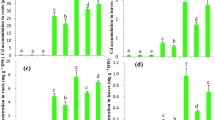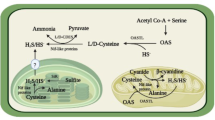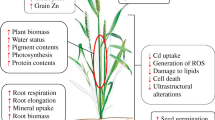Abstract
Reducing the accumulation of cadmium (Cd) and mitigating its toxicity are pivotal strategies for addressing Cd pollution’s threats to agriculture and human health. Hydrogen sulfide (H2S) serves as a signaling molecule, playing a crucial role in plant stress defense mechanisms. Nevertheless, a comprehensive assessment of the impact of exogenous H2S on plant growth, antioxidant properties, and gene expression under Cd stress remains lacking. In this meta-analysis, we synthesized 575 observations from 27 articles, revealing that exogenous H2S significantly alleviates Cd-induced growth inhibition in plants. Specifically, it enhances root length (by 8.71%), plant height (by 15.67%), fresh weight (by 15.15%), dry weight (by 22.54%), and chlorophyll content (by 27.99%) under Cd stress conditions. H2S boosts antioxidant enzyme activity, particularly catalase (CAT), by 39.51%, thereby reducing Cd-induced reactive oxygen species (ROS) accumulation. Moreover, it impedes Cd translocation from roots to shoots, resulting in a substantial 40.19% reduction in stem Cd content. Additionally, H2S influences gene expression in pathways associated with antioxidant enzymes, metal transport, heavy metal tolerance, H2S biosynthesis, and energy metabolism. However, the efficacy of exogenous H2S in alleviating Cd toxicity varies depending on factors such as plant species, concentration of the H2S donor sodium hydrosulfide (NaHS), application method, and cultivation techniques. Notably, NaHS concentrations exceeding 200 μM may adversely affect plants. Overall, our study underscores the role of exogenous H2S in mitigating Cd toxicity and elucidates its mechanism, providing insights for utilizing H2S to combat Cd pollution in agriculture.








Similar content being viewed by others
Data availability
The data supporting the findings of this study are available upon request from the corresponding author.
References
Ali B, Gill RA, Yang S, Gill MB, Ali S, Rafiq MT et al (2014) Hydrogen sulfide alleviates cadmium-induced morpho-physiological and ultrastructural changes in Brassica napus. Ecotoxicol Environ Saf 110:197–207. https://doi.org/10.1016/j.ecoenv.2014.08.027
Ali S, Nawaz A, Ejaz S, Haider STA, Alam MW, Javed HU (2019) Effects of hydrogen sulfide on postharvest physiology of fruits and vegetables: An overview. Sci Hortic 243:290–299. https://doi.org/10.1016/j.scienta.2018.08.037
Arif MS, Yasmeen T, Abbas Z, Ali S, Rizwan M, Aljarba NH et al (2021) Role of exogenous and endogenous hydrogen sulfide (H2S) on functional traits of plants under heavy metal stresses: a recent perspective. Front Plant Sci 11:545453. https://doi.org/10.3389/fpls.2020.545453
Aroca Á, Serna A, Gotor C, Romero LC (2015) S -Sulfhydration: A cysteine posttranslational modification in plant systems. Plant Physiol 168:334–342. https://doi.org/10.1104/pp.15.00009
Bakhiyi B, Gravel S, Ceballos D, Flynn MA, Zayed J (2018) Has the question of e-waste opened a Pandora’s box? An overview of unpredictable issues and challenges. Environ Int 110:173–192. https://doi.org/10.1016/j.envint.2017.10.021
Baruah N, Gogoi N, Roy S, Bora P, Chetia J, Zahra N et al (2023) Phytotoxic responses and plant tolerance mechanisms to cadmium toxicity. J Soil Sci Plant Nutr 23:4805–4826. https://doi.org/10.1007/s42729-023-01525-8
Carter JM, Brown EM, Irish EE, Bowden NB (2019) Characterization of dialkyldithiophosphates as slow hydrogen sulfide releasing chemicals and their effect on the growth of maize. J Agric Food Chem 67:11883–11892. https://doi.org/10.1021/acs.jafc.9b04398
Chen T, Tian M, Han Y (2020) Hydrogen sulfide: a multi-tasking signal molecule in the regulation of oxidative stress responses. J Exp Bot 71:2862–2869. https://doi.org/10.1093/jxb/eraa093
Chen S, Wang X, Jia H, Li F, Ma Y, Liesche J et al (2021) Persulfidation-induced structural change in SnRK2.6 establishes intramolecular interaction between phosphorylation and persulfidation. Mol Plant 14:1814–1830. https://doi.org/10.1016/j.molp.2021.07.002
Chen Z, Liu C, Cao B, Xu K (2022) A hydrogen sulfide application can alleviate the toxic effects of cadmium on ginger (Zingiber officinale Roscoe). Environ Sci Pollut Res 29:68422–68431. https://doi.org/10.1007/s11356-022-20635-x
Cheng W, Zhang L, Jiao C, Su M, Yang T, Zhou L et al (2013) Hydrogen sulfide alleviates hypoxia-induced root tip death in Pisum sativum. Plant Physiol Biochem 70:278–286. https://doi.org/10.1016/j.plaphy.2013.05.042
Corpas FJ, González-Gordo S, Cañas A, Palma JM (2019) Nitric oxide and hydrogen sulfide in plants: which comes first? J Exp Bot 70:4391–4404. https://doi.org/10.1093/jxb/erz031
Cui Y, Bai L, Li C, He Z, Liu X (2022) Assessment of heavy metal contamination levels and health risks in environmental media in the northeast region. Sustain Cities Soc 80:103796. https://doi.org/10.1016/j.scs.2022.103796
Cuypers A, Vanbuel I, Iven V, Kunnen K, Vandionant S, Huybrechts M et al (2023) Cadmium-induced oxidative stress responses and acclimation in plants require fine-tuning of redox biology at subcellular level. Free Radical Biol Med 199:81–96. https://doi.org/10.1016/j.freeradbiomed.2023.02.010
De Bont L, Mu X, Wei B, Han Y (2022) Abiotic stress-triggered oxidative challenges: Where does H2S act? J Genet Genomics 49:748–755. https://doi.org/10.1016/j.jgg.2022.02.019
Deckers J, Hendrix S, Prinsen E, Vangronsveld J, Cuypers A (2020) Identifying the pressure points of acute cadmium stress prior to acclimation in Arabidopsis thaliana. IJMS 21:6232. https://doi.org/10.3390/ijms21176232
Đukić-Ćosić D, Baralić K, Javorac D, Djordjevic AB, Bulat Z (2020) An overview of molecular mechanisms in cadmium toxicity. Curr Opin Toxicol 19:56–62. https://doi.org/10.1016/j.cotox.2019.12.002
Fang T, Cao Z, Li J, Shen W, Huang L (2014) Auxin-induced hydrogen sulfide generation is involved in lateral root formation in tomato. Plant Physiol Biochem 76:44–51. https://doi.org/10.1016/j.plaphy.2013.12.024
Fang H, Liu R, Yu Z, Shao Y, Wu G, Pei Y (2022) Gasotransmitter H2S accelerates seed germination via activating AOX mediated cyanide-resistant respiration pathway. Plant Physiol Biochem 190:193–202. https://doi.org/10.1016/j.plaphy.2022.09.003
Fu MM, Dawood M, Wang NH, Wu F (2019) Exogenous hydrogen sulfide reduces cadmium uptake and alleviates cadmium toxicity in barley. Plant Growth Regul 89:227–237. https://doi.org/10.1007/s10725-019-00529-8
Genchi G, Sinicropi MS, Lauria G, Carocci A, Catalano A (2020) The effects of cadmium toxicity. IJERPH 17:3782. https://doi.org/10.3390/ijerph17113782
Gharehbaghli N, Sepehri A (2022) The ameliorative effect of hydrogen sulfide on cadmium toxicity and oxidative stress damage in garlic (Allium sativum) seedlings. S Afr J Bot 150:161–170. https://doi.org/10.1016/j.sajb.2022.07.014
González-Gordo S, Palma JM, Corpas FJ (2020) Appraisal of H2S metabolism in Arabidopsis thaliana: In silico analysis at the subcellular level. Plant Physiol Biochem 155:579–588. https://doi.org/10.1016/j.plaphy.2020.08.014
Guan MY, Zhang HH, Pan W, ** CW, Lin XY (2018) Sulfide alleviates cadmium toxicity in Arabidopsis plants by altering the chemical form and the subcellular distribution of cadmium. Sci Total Environ 627:663–670. https://doi.org/10.1016/j.scitotenv.2018.01.245
Hamid Y, Tang L, Sohail MI, Cao X, Hussain B, Aziz MZ et al (2019) An explanation of soil amendments to reduce cadmium phytoavailability and transfer to food chain. Sci Total Environ 660:80–96. https://doi.org/10.1016/j.scitotenv.2018.12.419
Hasanuzzaman M, Bhuyan MHMB, Anee TI, Parvin K, Nahar K, Mahmud JA et al (2019) Regulation of ascorbate-glutathione pathway in mitigating oxidative damage in plants under abiotic stress. Antioxidants 8:384. https://doi.org/10.3390/antiox8090384
He M, Dijkstra FA (2014) Drought effect on plant nitrogen and phosphorus: a meta-analysis. New Phytol 204:924–931. https://doi.org/10.1111/nph.12952
Hou L, Wang Z, Gong G, Zhu Y, Ye Q, Lu S et al (2022) Hydrogen sulfide alleviates manganese stress in Arabidopsis. IJMS 23:5046. https://doi.org/10.3390/ijms23095046
Huang T, Yangcheng Li, Luo J, Wang J, Cai Z, Shen Y et al (2023) Hydrogen sulfide enhances resistance to Penicillium italicum by activating phenylpropanoid metabolism in postharvest navel orange fruit. Postharvest Biol Technol 198:112259. https://doi.org/10.1016/j.postharvbio.2023.112259
Ighodaro OM, Akinloye OA (2018) First line defence antioxidants-superoxide dismutase (SOD), catalase (CAT) and glutathione peroxidase (GPX): Their fundamental role in the entire antioxidant defence grid. Alexandria J Med 54:287–293. https://doi.org/10.1016/j.ajme.2017.09.001
Javad S, Shah AA, Ramzan M, Sardar R, Javed T, Al-Huqail AA et al (2022) Hydrogen sulphide alleviates cadmium stress in Trigonella foenum-graecum by modulating antioxidant enzymes and polyamine content. Plant Biol J 24:618–626. https://doi.org/10.1111/plb.13393
Jia H, Hu Y, Fan T, Li J (2015) Hydrogen sulfide modulates actin-dependent auxin transport via regulating ABPs results in changing of root development in Arabidopsis. Sci Rep 5:8251. https://doi.org/10.1038/srep08251
Jia H, Wang X, Shi C, Guo J, Ma P, Ren X et al (2020) Hydrogen sulfide decreases Cd translocation from root to shoot through increasing Cd accumulation in cell wall and decreasing Cd2+ influx in Isatis indigotica. Plant Physiol Biochem 155:605–612. https://doi.org/10.1016/j.plaphy.2020.08.033
Joshi P, Gupta A, Gupta V (2019) Insights into multifaceted activities of CysK for therapeutic interventions. 3 Biotech 9:44. https://doi.org/10.1007/s13205-019-1572-4
Kaya C, Shabala S (2023) Sodium hydrosulfide-mediated upregulation of nitrogen metabolism improves drought stress tolerance in pepper plants. Environ Exp Bot 209:105305. https://doi.org/10.1016/j.envexpbot.2023.105305
Li J, Chen S, Wang X, Shi C, Liu H, Yang J et al (2018) Hydrogen sulfide disturbs actin polymerization via S-Sulfhydration resulting in stunted root hair growth. Plant Physiol 178:936–949. https://doi.org/10.1104/pp.18.00838
Li L, Zhang Y, Ippolito JA, **ng W, Qiu K, Wang Y (2020) Cadmium foliar application affects wheat Cd, Cu, Pb and Zn accumulation. Environm Pollut 262:114329. https://doi.org/10.1016/j.envpol.2020.114329
Li C, Chen G, Huang D, Wang N, Liao W (2021a) The antioxidant defense system during Lanzhou Lily scales storage is modulated by hydrogen sulfide. Horticulturae 7:183. https://doi.org/10.3390/horticulturae7070183
Li H, Ghoto K, Wei MY, Gao CH, Liu YL, Ma DN et al (2021b) Unraveling hydrogen sulfide-promoted lateral root development and growth in mangrove plant Kandelia obovata : insight into regulatory mechanism by TMT-based quantitative proteomic approaches. Tree Physiol 41:1749–1766. https://doi.org/10.1093/treephys/tpab025
Li Y, Sun D, Xu K, ** L, Peng R (2021c) Hydrogen sulfide enhances plant tolerance to waterlogging stress. Plants 10:1928. https://doi.org/10.3390/plants10091928
Li H, Chen H, Chen L, Wang C (2022) The role of hydrogen sulfide in plant roots during development and in response to abiotic stress. IJMS 23:1024. https://doi.org/10.3390/ijms23031024
Luo S, Tang Z, Yu J, Liao W, **e J, Lv J et al (2022) Hydrogen sulfide inhibits cadmium-induced cell death of cucumber seedling root tips by protecting mitochondrial physiological function. J Plant Growth Regul 41:3421–3432. https://doi.org/10.1007/s00344-021-10524-x
McGrath SP (2022) Kee** toxic cadmium out of the food chain. Nat Food 3:569–570. https://doi.org/10.1038/s43016-022-00579-8
Olson KR (2018) H2S and polysulfide metabolism: Conventional and unconventional pathways. Biochem Pharmacol 149:77–90. https://doi.org/10.1016/j.bcp.2017.12.010
Raju AD, Prasad SM (2021) Hydrogen sulfide implications on easing NaCl induced toxicity in eggplant and tomato seedlings. Plant Physiol Biochem 164:173–184. https://doi.org/10.1016/j.plaphy.2021.05.001
Ren H, Shen WJ, Lu HF, Wen XY, Jian SG (2007) Degraded ecosystems in China: status, causes, and restoration efforts. Landsc Ecol Eng 3:1–13. https://doi.org/10.1007/s11355-006-0018-4
Rizwan M, Mostofa MG, Ahmad MZ, Zhou Y, Adeel M, Mehmood S et al (2019) Hydrogen sulfide enhances rice tolerance to nickel through the prevention of chloroplast damage and the improvement of nitrogen metabolism under excessive nickel. Plant Physiol Biochem 138:100–111. https://doi.org/10.1016/j.plaphy.2019.02.023
Ronzan M, Piacentini D, Fattorini L, Della Rovere F, Eiche E, Riemann M et al (2018) Cadmium and arsenic affect root development in Oryza sativa L. negatively interacting with auxin. Environ Exp Bot 151:64–75. https://doi.org/10.1016/j.envexpbot.2018.04.008
Singh SK, Suhel M, Husain T, Prasad SM, Singh VP (2022) Hydrogen sulfide manages hexavalent chromium toxicity in wheat and rice seedlings: The role of sulfur assimilation and ascorbate-glutathione cycle. Environ Pollut 307:119509. https://doi.org/10.1016/j.envpol.2022.119509
Singh R, Singh S, Parihar P, Mishra RK, Tripathi DK, Singh VP et al (2016) Reactive oxygen species (ROS): beneficial companions of plants’ developmental processes. Front Plant Sci 7. https://doi.org/10.3389/fpls.2016.01299
Sun J, Wang R, Zhang X, Yu Y, Zhao R, Li Z et al (2013) Hydrogen sulfide alleviates cadmium toxicity through regulations of cadmium transport across the plasma and vacuolar membranes in Populus euphratica cells. Plant Physiol Biochem 65:67–74. https://doi.org/10.1016/j.plaphy.2013.01.003
Sun YY, Wang JQ, **ang RH, Li ZG et al (2022) Key role of reactive oxygen species-scavenging system in nitric oxide and hydrogen sulfide crosstalk-evoked thermotolerance in maize seedlings. Front Plant Sci 13:967968. https://doi.org/10.3389/fpls.2022.967968
Thakur M, Anand A et al (2021) Hydrogen sulfide: An emerging signaling molecule regulating drought stress response in plants. Physiol Plant 172:1227–1243. https://doi.org/10.1111/ppl.13432
Thompson CR, Kats G (1978) Effects of continuous hydrogen sulfide fumigation on crop and forest plants. Environ Sci Technol 12:550–553. https://doi.org/10.1021/es60141a001
Wang HR, Che YH, Huang D, Ao H (2020) Hydrogen sulfide mediated alleviation of cadmium toxicity in Phlox paniculata L. and establishment of a comprehensive evaluation model for corresponding strategy. Int J Phytorem 22:1085–1095. https://doi.org/10.1080/15226514.2020.1730299
Wang P, Fang H, Gao R, Liao W (2021) Protein persulfidation in plants: function and mechanism. Antioxidants 10:1631. https://doi.org/10.3390/antiox10101631
Wang H, Cheng Z, Li J, Fang L, Chen T, Zhu B et al (2023) The TaWRKY13–TaNHX2 pathway positively regulates cadmium tolerance by inhibiting the expression of TaHMA2. Environ Exp Bot 211:105378. https://doi.org/10.1016/j.envexpbot.2023.105378
Wirtz M (2004) O-acetylserine (thiol) lyase: an enigmatic enzyme of plant cysteine biosynthesis revisited in Arabidopsis thaliana. J Exp Bot 55:1785–1798. https://doi.org/10.1093/jxb/erh201
**ang Z, Li W, Lu Y, Yuan T (2023) Hydrogen sulfide alleviates osmotic stress-induced root growth inhibition by promoting auxin homeostasis. Plant J 114:1369–1384. https://doi.org/10.1111/tpj.16198
Yang X, Ren J, Yang W, Xue J, Gao Z, Yang Z (2023) Hydrogen sulfide alleviates chromium toxicity by promoting chromium sequestration and re-establishing redox homeostasis in Zea mays L. Environ Pollut 332:121958. https://doi.org/10.1016/j.envpol.2023.121958
Yu Y, Dong J, Li R, Zhao X, Zhu Z, Zhang F et al (2023) Sodium hydrosulfide alleviates aluminum toxicity in Brassica napus through maintaining H2S, ROS homeostasis and enhancing aluminum exclusion. Sci Total Environ 858:160073. https://doi.org/10.1016/j.scitotenv.2022.160073
Yuan X, Xue N, Han Z et al (2021) A meta-analysis of heavy metals pollution in farmland and urban soils in China over the past 20 years. J Environ Sci 101:217–226. https://doi.org/10.1016/j.jes.2020.08.013
Zhang L, Pei Y, Wang H, ** Z, Liu Z, Qiao Z et al (2015) Hydrogen sulfide alleviates cadmium-induced cell death through restraining ROS accumulation in roots of Brassica rapa L. ssp. pekinensis. Oxid Med Cell Longev 2015:804603. https://doi.org/10.1155/2015/804603
Zhang P, Luo Q, Wang R, Xu J (2017) Hydrogen sulfide toxicity inhibits primary root growth through the ROS-NO pathway. Sci Rep 7:868. https://doi.org/10.1038/s41598-017-01046-2
Zhang D, Zhang Y, Zhou H, Wang H, Gao Y, Shao L et al (2022) Chalcogens reduce grain Cd accumulation by enhancing Cd root efflux and upper organ retention in wheat (Triticum aestivum L.). Environ Exp Bot 201:104975. https://doi.org/10.1016/j.envexpbot.2022.104975
Zhang Q, Wen Q, Ma T, Zhu Q, Huang D, Zhu H et al (2023) Cadmium-induced iron deficiency is a compromise strategy to reduce Cd uptake in rice. Environ Exp Bot 206:105155. https://doi.org/10.1016/j.envexpbot.2022.105155
Zheng X, Zhang B, Pan N, Cheng X, Lu W et al (2023) Hydrogen sulfide alleviates cadmium stress by enhancing photosynthetic efficiency and regulating sugar metabolism in wheat seedlings. Plants 12:2413. https://doi.org/10.3390/plants12132413
Zhu CQ, Zhang JH, Sun LM, Zhu LF, Abliz B, Hu WJ et al (2018) Hydrogen sulfide alleviates aluminum toxicity via decreasing apoplast and symplast Al contents in rice. Front Plant Sci 9:294. https://doi.org/10.3389/fpls.2018.00294
Zhu D, Hou L, **ao P, Guo Y, Deyholos MK, Liu X (2019) VvWRKY30, a grape WRKY transcription factor, plays a positive regulatory role under salinity stress. Plant Sci 280:132–142. https://doi.org/10.1016/j.plantsci.2018.03.018
Zhu CQ, Wei Q, Hu WJ, Kong YL, **ang XJ, Zhang H et al (2022) Unearthing the alleviatory mechanisms of hydrogen sulfide in aluminum toxicity in rice. Plant Physiol Biochem 182:133–144. https://doi.org/10.1016/j.plaphy.2022.04.006
Acknowledgements
This work was supported by the Chongqing Municipal Water Conservancy Science and Technology Project [Grant No. CQSLK-2023027], the Science and Technology Research Program of Chongqing Municipal Education Commission [Grant No. KJQN202001509], the Postgraduate Science and Technology Innovation Program of Chongqing University of Science and Technology [Grant No. YKJCX2220534], and the Undergraduate Innovation Training Program of Chongqing Municipal Education Commission [Grant No. s202311551004].
Author information
Authors and Affiliations
Contributions
Han** Cao: Data curation, Software, Writing-original draft. Ke** Song: Methodology, Visualization. Yingying Hu: Validation. Qingxiao Li: Data curation. Tengfei Ma: Software. Rui Li: Revising. Nan Chen: Funding acquisition. Shunqin Zhu: Writing-review and editing. Wanhong Liu: Conceptualization, Project administration, Supervision.
Corresponding author
Ethics declarations
Competing interest
All the authors declare no conflict of interest.
Additional information
Responsible Editor: Gangrong Shi
Publisher's Note
Springer Nature remains neutral with regard to jurisdictional claims in published maps and institutional affiliations.
Supplementary Information
Below is the link to the electronic supplementary material.
Rights and permissions
Springer Nature or its licensor (e.g. a society or other partner) holds exclusive rights to this article under a publishing agreement with the author(s) or other rightsholder(s); author self-archiving of the accepted manuscript version of this article is solely governed by the terms of such publishing agreement and applicable law.
About this article
Cite this article
Cao, H., Song, K., Hu, Y. et al. The role of exogenous hydrogen sulfide in mitigating cadmium toxicity in plants: A comprehensive meta-analysis. Environ Sci Pollut Res 31, 30273–30287 (2024). https://doi.org/10.1007/s11356-024-33298-7
Received:
Accepted:
Published:
Issue Date:
DOI: https://doi.org/10.1007/s11356-024-33298-7




